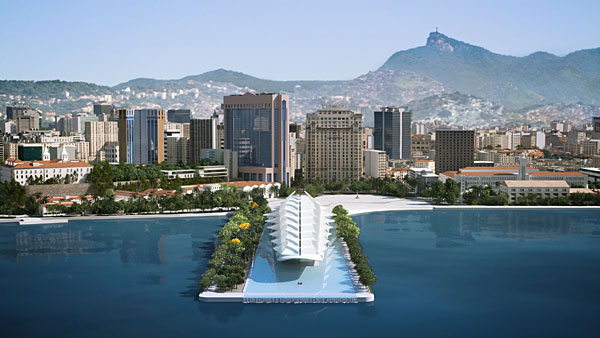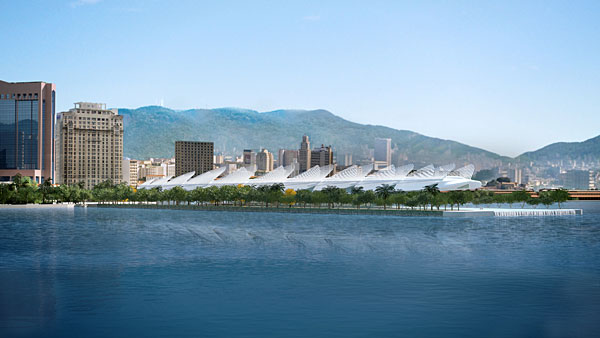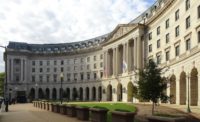
|
| Image courtesy Santiago Calatrava |
|
Located on Pier Maua, adjacent to Rio¹s main cruise ship terminal, the Museu do Amanhã will anchor a $2.8 billion waterfront redevelopment plan dubbed "Marvelous Port." |
As Rio de Janeiro prepares to host several high-profile events, including the United Nations’ 2012 “Rio+20” Earth Summit, and the 2016 Summer Olympics, the city is unveiling major architecture commissions and urban improvements. One such undertaking breaks ground this month: the Museu do Amanhã, or Museum of Tomorrow, designed by Santiago Calatrava.
Located on Pier Maua, adjacent to Rio’s main cruise ship terminal, the museum will anchor a $2.8 billion waterfront redevelopment plan dubbed “Marvelous Port.” The 134,549-square-foot building and surrounding 5.4 acres of gardens and pools will showcase science and sustainability—suggesting a path for future, greener development.
“It will be a living museum and pedagogical tool,” Calatrava explains. “We want it to exemplify ecology for young people who’ve never heard about it. They’ll be able to see how things work with their own eyes.”
The rectangular, concrete building’s most prominent feature is a series of photovoltaic panels protruding from its steel roof. During the daytime, they will tilt to follow the sun’s course across the sky. “They’re not passive elements,” Calatrava says. “The building changes like a flower or a plant.”

|
| Image courtesy Santiago Calatrava |
|
The Museu do Amanhã is scheduled to break ground this month. |
Other pedagogic green features include pools to capture rainwater, for use in the plumbing system, as well as pools that naturally filter water from the bay. Pumps will harvest seawater, moreover, to cool interior rooms and galleries—all features that could earn LEED certification from the Green Building Council Brasil, an affiliate of the USGBC.
As for the museum’s contents, Hugo Barreto, secretary general of the project’s developer, the Fundação Roberto Marinho, describes it as “a collection of possibilities for the future.” If this sounds ambiguous, the foundation has experience taking abstract concepts and making them concrete. It commissioned Paulo Mendes da Rocha to design the Museum of the Portugeuse Language, in São Paolo, and Diller Scofidio + Renfro to design a Museum of Image & Sound, currently under construction in Rio.
At the Museum of Tomorrow, interactive exhibits designed by Manhattan-based Ralph Appelbaum Associates will contextualize sustainability within Brazil’s landscape. Visitors will enter from a ground-level plaza then ascend to an upper level via two long ramps—one geared toward children, the other for adults—that terminate in windows overlooking the bay. From there, they will pass through a vestibule that rotates 180 degrees and deposits them into a high-ceilinged, nave-like gallery running the building’s length.
Dockside, Calatrava has proposed removing an elevated highway and extending the nearby Praça Mauá, a plaza bounded on its southern end by Rio’s first skyscraper, the Edificio do Jornal A Noite. Although the city is still evaluating this element, construction of the $49 million museum begins this fall. The gardens and a plaza-level auditorium should open by 2012, in time to host Earth Summit events.
“The summit, the 2014 World Cup, and the Olympics are a huge opportunity to rehabilitate areas like the seaport,” Barreto says, adding that he hopes Calatrava’s Museum of Tomorrow will similarly become a catalyst and “iconic emblem” for more projects like it.
The trio of major events is already inspiring other architects to design sustainable projects. The Swiss firm RAFAA, for instance, in June unveiled Solar City Tower, its proposal for an artificial waterfall in Rio’s harbor. Photovoltaic panels would power pumps to haul seawater 344 feet above the bay, then send water tumbling down past electricity-generating turbines that would help power athlete housing during the 2016 Olympics.
“We tried to make this project the representation of an inner attitude, a symbol of a society facing the future,” explains Rafael Schmidt, RAFAA’s director. “This is why we proposed infrastructure and not a monument.” He adds that RAFAA contacted Carlos Nuzman, president of the Brazilian Olympic Committee, to gauge interest in building the tower but has yet to receive a response. With or without a solar tower, one thing is certain—Rio is set to capture the world’s attention in a big way.






Post a comment to this article
Report Abusive Comment